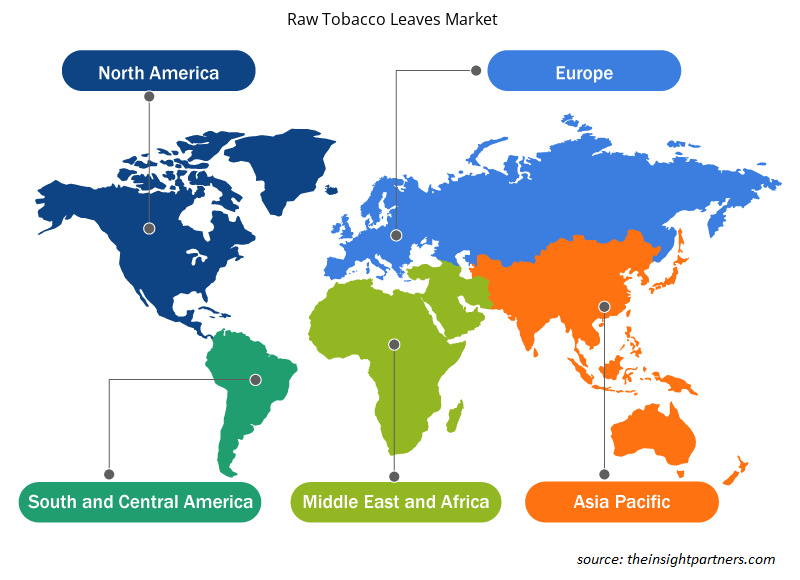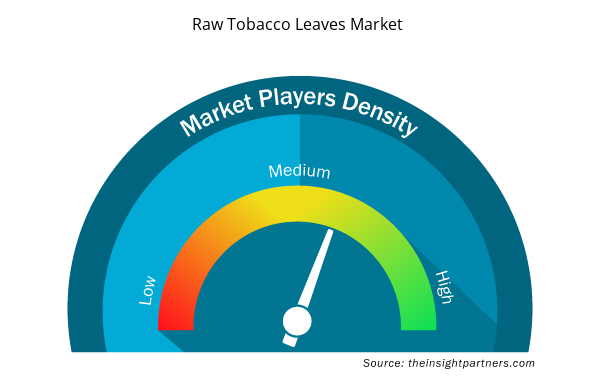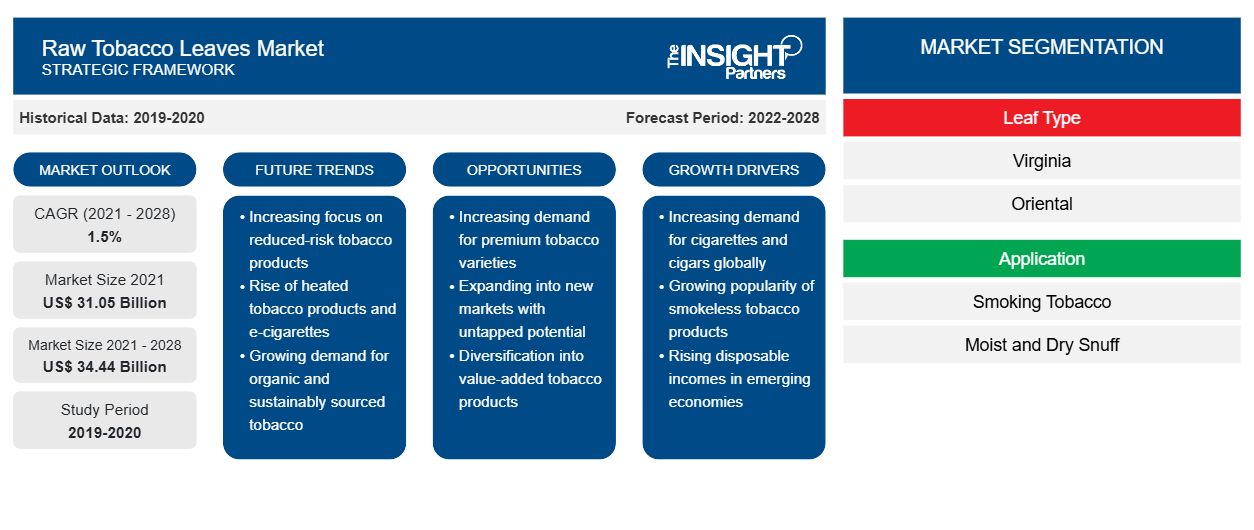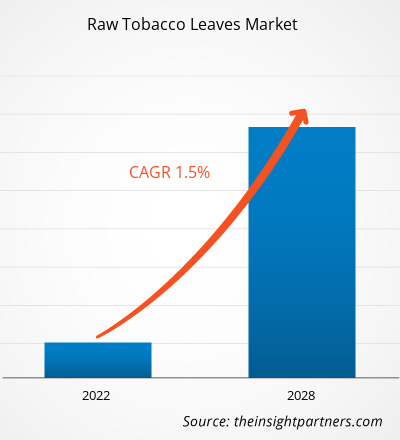Der Markt für Rohtabakblätter wurde im Jahr 2021 auf 31.045,19 Millionen US-Dollar geschätzt und soll bis 2028 34.436,28 Millionen US-Dollar erreichen; von 2021 bis 2028 wird mit einer durchschnittlichen jährlichen Wachstumsrate von 1,5 % gerechnet.
Tabakprodukte werden durch Trocknen von rohen Tabakblättern hergestellt. Tabakblätter enthalten Nikotin und ein flüchtiges Alkaloid, das die Gehirnfunktion stimuliert. Darüber hinaus wird erwartet, dass kontinuierliche Innovationen bei Tabakprodukten und staatliche Vorschriften für den Verkauf von rohen Tabakblättern im Prognosezeitraum lukrative Möglichkeiten für aktive Anbieter schaffen werden.
Im Prognosezeitraum wird der asiatisch-pazifische Raum voraussichtlich den größten Anteil am weltweiten Markt für Rohtabakblätter haben . Laut dem Asia-Pacific Heart Network weist die Region die höchste Raucherquote der Welt auf. In der Region werden jährlich 2,3 Millionen Todesfälle aufgrund von tabakbedingten Krankheiten verzeichnet, was etwa der Hälfte der jährlich 5 Millionen tabakbedingten Todesfälle weltweit entspricht. Darüber hinaus werden Verbesserungen der Einzelhandelsinfrastruktur und intensive Markenkampagnen namhafter Tabakunternehmen wie Philip Morris International und British American Tobacco in Schlüsselmärkten wie China, Bangladesch, Indien und den Philippinen voraussichtlich die Marktexpansion in dieser Region unterstützen.
Die anhaltende COVID-19-Pandemie hat den Status des Marktes für Rohtabakblätter drastisch verändert. Die Pandemie hatte den größten Einfluss auf die Produktions-, Logistik- sowie Tourismus- und Reisebranche. Der Ausbruch zwang die Regierungen zahlreicher Länder, Ausgangssperren zu verhängen , um die Ausbreitung des Virus einzudämmen. Daher haben mehrere Unternehmen Ausfallzeiten und einige Unternehmen arbeiten aus der Ferne, was zu geringer Produktivität und Einkommen führt. Die COVID-19-Pandemie hat zu erheblichen gesellschaftlichen und wirtschaftlichen Störungen geführt und zur Schließung von Geschäften, Fabriken und Büros geführt. Die Krise führte auch zu Beschränkungen bei Herstellung, Vertrieb und Reisen. All diese Faktoren wirkten sich während der anhaltenden Pandemie negativ auf Unternehmen, Betrieb, Cashflows und Finanzlage aus. Die Rohtabakblätterindustrie wuchs vor dem COVID-19-Ausbruch erheblich. In letzter Zeit ist sie jedoch instabil, da die Verbraucher bei ihren Einkäufen wählerisch sind. Der Zustand hat die Nachfrage nach Tabak erheblich gestört. In mehreren Ländern werden Tabakprodukte als nicht lebensnotwendige Artikel eingestuft, was die Nachfrage nach Rohtabakblättern und Tabakprodukten weltweit verringert hat. COVID-19 ist eine Atemwegserkrankung und verursacht Atemprobleme. Daher vermeiden die Menschen den Konsum von Tabakprodukten. Außerdem wird Tabakrauchern geraten, mit dem Rauchen aufzuhören, um das Risiko einer Infektion mit dem Virus zu senken. Daher wird erwartet, dass der COVID-19-Ausbruch das Wachstum des Marktes für Rohtabakblätter in Zukunft bremsen wird.
Passen Sie diesen Bericht Ihren Anforderungen an
Sie erhalten kostenlose Anpassungen an jedem Bericht, einschließlich Teilen dieses Berichts oder einer Analyse auf Länderebene, eines Excel-Datenpakets sowie tolle Angebote und Rabatte für Start-ups und Universitäten.
- Holen Sie sich die wichtigsten Markttrends aus diesem Bericht.Dieses KOSTENLOSE Beispiel umfasst eine Datenanalyse von Markttrends bis hin zu Schätzungen und Prognosen.
Markteinblicke
Steigender Konsum von Tabakprodukten in Entwicklungsregionen
Die Nachfrage nach Tabakprodukten steigt in Regionen wie dem Asien-Pazifik-Raum und dem Nahen Osten und Afrika stark an. Der Nachfrageanstieg im Asien-Pazifik-Raum ist auf die steigende Bevölkerung, das steigende Einkommensniveau der Verbraucher und laxe staatliche Regulierungen zurückzuführen. Der Markt in Schwellenregionen wie dem Asien-Pazifik-Raum und dem Nahen Osten und Afrika dürfte im Prognosezeitraum ein beträchtliches Wachstum verzeichnen. Das Wachstum der Einzelhandelsinfrastruktur und groß angelegte Markenkampagnen führender Tabak produzierender Unternehmen wie Philip Morris International und British American Tobacco in Hauptmärkten wie Indien, China, Bangladesch und den Philippinen dürften das Marktwachstum im Asien-Pazifik-Raum in den kommenden Jahren ankurbeln. Die Bemühungen multinationaler Tabakunternehmen, die Tabakproduktion in den Schwellenregionen anzukurbeln und auszubauen, sollen den steigenden Bedarf ihrer Auslandsmärkte an leicht verfügbaren und günstigeren Tabakblättern decken.
Der asiatisch-pazifische Raum ist einer der weltweit bedeutendsten Tabakproduzenten und -konsumenten, angeführt von Ländern wie Indien und China. Vier der weltweit größten Tabakunternehmen sind Japan Tobacco Inc., China National Tobacco Corporation, ITC Limited und PT Gudang Garam Tbk , und sie haben ihren Sitz im asiatisch-pazifischen Raum. Darüber hinaus ist China der größte Markt in der Region, da ein erheblicher Prozentsatz der Bevölkerung Tabakprodukte konsumiert. Laxe Regulierungen in Ländern, wie beispielsweise das Verbot des Konsums von Tabakprodukten an öffentlichen Orten in Indien, und die zunehmende Verfügbarkeit von Tabakprodukten in modernen Einzelhandelsgeschäften in der Region treiben das Wachstum des Marktes für Rohtabakblätter im asiatisch-pazifischen Raum aktiv an.
Einblicke in die Blattart
Basierend auf der Blattart ist der globale Markt für Rohtabakblätter segmentiert in Virginia , Oriental und Sonstige. Das Virginia- Segment wird im Prognosezeitraum voraussichtlich den größten Marktanteil halten. Virginia oder flue-cured Tabak ist wegen seiner goldgelben bis tieforangen Farbe während der Trocknung auch als „heller Tabak“ bekannt. Er wird typischerweise eine Woche lang in beheizten Scheunen getrocknet und hat ein leichtes, lebendiges Aroma und Aroma. Er wächst außergewöhnlich gut in regnerischen Gebieten wie Georgia (USA), Südbrasilien und Simbabwe und ist in fast jeder Zigarettenmischung zu finden. Virginia-Tabak ist der weltweit am meisten konsumierte Tabak. Er wird auf verschiedene Arten angebaut, geerntet, getrocknet und verarbeitet. Sein Nikotingehalt liegt zwischen 1 % und 4 % und sein Zuckergehalt zwischen 4 % und 25 %. Virginia-Tabak enthält viel Zucker und macht den Zigarettenrauch süßer.
Anwendungseinblicke
Der Markt für rohe Tabakblätter ist je nach Anwendung in Rauchtabak, feuchten und trockenen Schnupftabak und andere unterteilt. Das Segment Rauchtabak wird im Prognosezeitraum voraussichtlich den größten Marktanteil halten. Rohe Tabakblätter werden hauptsächlich zum Rauchen in Produkten wie Zigaretten, selbstgedrehten Zigaretten, Zigarren, Wasserpfeifen, E-Zigaretten und E-Zigaretten verwendet. Beim Tabakrauchen wird der Rauch eingeatmet, der durch das Verbrennen trockener oder getrockneter Tabakblätter entsteht. Die biochemisch aktiven Bestandteile des Tabaks, wie Nikotin und TSNA, werden bei der Verbrennung freigesetzt und können über die Lunge aufgenommen werden. Tabak ist der Hauptbestandteil von Rauchtabakprodukten. Virginia, Burley und Oriental sind drei Tabaksorten, die häufig zur Herstellung von Tabakprodukten verwendet werden. Laut einer Umfrage des Behavioral Risk Factor Surveillance System aus dem Jahr 2016 waren 44,3 % der derzeitigen jungen erwachsenen E-Zigarettennutzer nie Raucher, bevor sie E-Zigaretten ausprobierten. Darüber hinaus nutzen immer mehr junge Erwachsene im Alter zwischen 18 und 24 Jahren E-Zigaretten. Einer aktuellen Studie zufolge stieg der Anteil junger Erwachsener, die täglich oder an einigen Tagen E-Zigaretten verwenden, von 2,4 % im Jahr 2012–2013 auf 5,2 % im Jahr 2017 und stieg dann erneut auf 7,6 % im Jahr 2018.
Universal Corporation, Sopariwala Exports, Alliance One International Inc., Leaf Only, British American Tobacco plc, Leafcon International, BBM Bommidala Group, Star Agritech International, JT Group und US Tobacco Cooperative Inc. gehören zu den etablierten Akteuren auf dem globalen Markt für Rohtabakblätter. Diese Unternehmen bieten ihre Produkte weltweit an.
Bericht-Spotlights
- Fortschrittliche Branchentrends auf dem globalen Markt für Rohtabakblätter helfen den Akteuren bei der Entwicklung wirksamer langfristiger Strategien
- In Industrie- und Entwicklungsländern angewandte Strategien für Unternehmenswachstum
- Quantitative Analyse des globalen Marktes für Rohtabakblätter von 2019 bis 2028
- Schätzung der Nachfrage nach Rohtabakblättern in verschiedenen Branchen
- Porters Fünf-Kräfte-Analyse zur Veranschaulichung der Wirksamkeit der in der Branche tätigen Anbieter bei der Vorhersage des Marktwachstums
- Aktuelle Entwicklungen zum Verständnis der Wettbewerbssituation auf dem Markt und der Nachfrage nach Rohtabakblättern
- Markttrends und -aussichten in Verbindung mit Faktoren, die das Wachstum des Marktes für Rohtabakblätter vorantreiben und bremsen
- Entscheidungsprozess durch das Verständnis von Strategien, die das kommerzielle Interesse im Hinblick auf das Wachstum des globalen Marktes für Rohtabakblätter untermauern
- Marktgröße für Rohtabakblätter an verschiedenen Marktknoten
- Detaillierte Übersicht und Segmentierung des globalen Marktes für Rohtabakblätter sowie seiner Dynamik in der Branche
- Marktgröße für Rohtabakblätter in verschiedenen Regionen mit vielversprechenden Wachstumschancen
Regionale Einblicke in den Markt für Rohtabakblätter
Die regionalen Trends und Faktoren, die den Markt für Rohtabakblätter während des Prognosezeitraums beeinflussen, wurden von den Analysten von Insight Partners ausführlich erläutert. In diesem Abschnitt werden auch die Marktsegmente und die Geografie für Rohtabakblätter in Nordamerika, Europa, im asiatisch-pazifischen Raum, im Nahen Osten und Afrika sowie in Süd- und Mittelamerika erörtert.

- Erhalten Sie regionale Daten zum Markt für rohe Tabakblätter
Umfang des Marktberichts über rohe Tabakblätter
| Berichtsattribut | Details |
|---|---|
| Marktgröße im Jahr 2021 | 31,05 Milliarden US-Dollar |
| Marktgröße bis 2028 | 34,44 Milliarden US-Dollar |
| Globale CAGR (2021 - 2028) | 1,5 % |
| Historische Daten | 2019-2020 |
| Prognosezeitraum | 2022–2028 |
| Abgedeckte Segmente | Nach Blatttyp
|
| Abgedeckte Regionen und Länder | Nordamerika
|
| Marktführer und wichtige Unternehmensprofile |
|
Dichte der Marktteilnehmer auf Rohtabakblättern: Deren Auswirkungen auf die Geschäftsdynamik
Der Markt für rohe Tabakblätter wächst rasant, angetrieben von der steigenden Nachfrage der Endverbraucher aufgrund von Faktoren wie sich entwickelnden Verbraucherpräferenzen, technologischen Fortschritten und einem größeren Bewusstsein für die Vorteile des Produkts. Mit steigender Nachfrage erweitern Unternehmen ihr Angebot, entwickeln Innovationen, um die Bedürfnisse der Verbraucher zu erfüllen, und nutzen neue Trends, was das Marktwachstum weiter ankurbelt.
Die Marktteilnehmerdichte bezieht sich auf die Verteilung der Firmen oder Unternehmen, die in einem bestimmten Markt oder einer bestimmten Branche tätig sind. Sie gibt an, wie viele Wettbewerber (Marktteilnehmer) in einem bestimmten Marktraum im Verhältnis zu seiner Größe oder seinem gesamten Marktwert präsent sind.
Die wichtigsten auf dem Markt für Rohtabakblätter tätigen Unternehmen sind:
- Universal Corporation
- Sopariwala-Exporte
- Alliance One International Inc.
- Nur Blatt
- British American Tobacco plc
Haftungsausschluss : Die oben aufgeführten Unternehmen sind nicht in einer bestimmten Reihenfolge aufgeführt.

- Überblick über die wichtigsten Akteure auf dem Markt für rohe Tabakblätter
Markt für rohe Tabakblätter, nach Blatttyp
- Virginia
- orientalisch
- Sonstiges
Markt für rohe Tabakblätter, nach Anwendung
- Tabak rauchen
- Feuchter und trockener Schnupftabak
- Sonstiges
Firmenprofile
- Universal Corporation
- Sopariwala- Exporte
- Alliance One International Inc.
- Nur Blatt
- British American Tobacco plc
- Leafcon International
- BBM Bommidala Gruppe
- Star Agritech International
- JT- Gruppe
- US Tobacco Cooperative Inc.
- Historische Analyse (2 Jahre), Basisjahr, Prognose (7 Jahre) mit CAGR
- PEST- und SWOT-Analyse
- Marktgröße Wert/Volumen – Global, Regional, Land
- Branche und Wettbewerbsumfeld
- Excel-Datensatz



Report Coverage
Revenue forecast, Company Analysis, Industry landscape, Growth factors, and Trends

Segment Covered
This text is related
to segments covered.

Regional Scope
North America, Europe, Asia Pacific, Middle East & Africa, South & Central America

Country Scope
This text is related
to country scope.
Häufig gestellte Fragen
The overall threat of rivalry in raw tobacco leaves market is high. Rivalry is a high threat to profit when there are more than two competitors of similar size. Herein, competitive rivalry is intense as the industry’s products are undifferentiated. This makes for intense rivalry because competitors are constantly seeking ways to reach a competitive advantage over one another to gain market share.
The major players operating in the global raw tobacco leaves market are Universal Corporation, Sopariwala Exports, Alliance One International Inc., Leaf Only, British American Tobacco p.l.c., Leafcon International, BBM Bommidala Group, Star Agritech International, JT Group, U.S. Tobacco Cooperative Inc. and many others.
In 2020, Asia-Pacific accounted for the largest share of more than 55% in the global raw tobacco leaves market. The Asia-Pacific region has some of the highest smoking rates in the world, with 2.3 million deaths from tobacco-related diseases per year, accounting for about half of the 5 million global tobacco deaths each year. Further, improvements in retail infrastructure and intensive brand campaigns by prominent tobacco companies such as Philip Morris International and British American Tobacco, in key markets such as China, Bangladesh, India, and the Philippines, are likely to support market expansion in this region.
Based on application, the smoking tobacco segment dominated the market in 2020 and is expected to maintain its dominance throughout the forecast period. Raw tobacco leaves are mainly used for smoking in products such as cigarettes, roll-your-own, cigars, water pipes, e-cigarettes, and vapes. Tobacco smoking is the act of inhaling the smoke produced by burning dry or cured tobacco leaves. Tobacco's biochemically active components, such as nicotine and TSNA, are released during combustion and can be absorbed through the lungs. Tobacco is the core component of smoking tobacco products.
The global raw tobacco leaves market growth is majorly influenced by determinants such as increasing consumption of tobacco products in developing countries, rising health awareness regarding the health concerns of tobacco, and strategic investments by the prominent market players.
The Virginia segment is expected to dominate the market during the forecast period. Virginia, or flue-cured tobacco, is also known as 'bright tobacco' because of the golden-yellow to deep-orange color while curing. It is typically cured for a week in heated barns and has a light, vibrant flavor, and taste. It grows exceptionally well in rainy areas, such as Georgia (USA), southern Brazil, and Zimbabwe, and can be found in almost every cigarette blend. Virginia tobacco is the most widely consumed tobacco in the world.
Trends and growth analysis reports related to Consumer Goods : READ MORE..
The Insight Partners performs research in 4 major stages: Data Collection & Secondary Research, Primary Research, Data Analysis and Data Triangulation & Final Review.
- Data Collection and Secondary Research:
As a market research and consulting firm operating from a decade, we have published and advised several client across the globe. First step for any study will start with an assessment of currently available data and insights from existing reports. Further, historical and current market information is collected from Investor Presentations, Annual Reports, SEC Filings, etc., and other information related to company’s performance and market positioning are gathered from Paid Databases (Factiva, Hoovers, and Reuters) and various other publications available in public domain.
Several associations trade associates, technical forums, institutes, societies and organization are accessed to gain technical as well as market related insights through their publications such as research papers, blogs and press releases related to the studies are referred to get cues about the market. Further, white papers, journals, magazines, and other news articles published in last 3 years are scrutinized and analyzed to understand the current market trends.
- Primary Research:
The primarily interview analysis comprise of data obtained from industry participants interview and answers to survey questions gathered by in-house primary team.
For primary research, interviews are conducted with industry experts/CEOs/Marketing Managers/VPs/Subject Matter Experts from both demand and supply side to get a 360-degree view of the market. The primary team conducts several interviews based on the complexity of the markets to understand the various market trends and dynamics which makes research more credible and precise.
A typical research interview fulfils the following functions:
- Provides first-hand information on the market size, market trends, growth trends, competitive landscape, and outlook
- Validates and strengthens in-house secondary research findings
- Develops the analysis team’s expertise and market understanding
Primary research involves email interactions and telephone interviews for each market, category, segment, and sub-segment across geographies. The participants who typically take part in such a process include, but are not limited to:
- Industry participants: VPs, business development managers, market intelligence managers and national sales managers
- Outside experts: Valuation experts, research analysts and key opinion leaders specializing in the electronics and semiconductor industry.
Below is the breakup of our primary respondents by company, designation, and region:

Once we receive the confirmation from primary research sources or primary respondents, we finalize the base year market estimation and forecast the data as per the macroeconomic and microeconomic factors assessed during data collection.
- Data Analysis:
Once data is validated through both secondary as well as primary respondents, we finalize the market estimations by hypothesis formulation and factor analysis at regional and country level.
- Macro-Economic Factor Analysis:
We analyse macroeconomic indicators such the gross domestic product (GDP), increase in the demand for goods and services across industries, technological advancement, regional economic growth, governmental policies, the influence of COVID-19, PEST analysis, and other aspects. This analysis aids in setting benchmarks for various nations/regions and approximating market splits. Additionally, the general trend of the aforementioned components aid in determining the market's development possibilities.
- Country Level Data:
Various factors that are especially aligned to the country are taken into account to determine the market size for a certain area and country, including the presence of vendors, such as headquarters and offices, the country's GDP, demand patterns, and industry growth. To comprehend the market dynamics for the nation, a number of growth variables, inhibitors, application areas, and current market trends are researched. The aforementioned elements aid in determining the country's overall market's growth potential.
- Company Profile:
The “Table of Contents” is formulated by listing and analyzing more than 25 - 30 companies operating in the market ecosystem across geographies. However, we profile only 10 companies as a standard practice in our syndicate reports. These 10 companies comprise leading, emerging, and regional players. Nonetheless, our analysis is not restricted to the 10 listed companies, we also analyze other companies present in the market to develop a holistic view and understand the prevailing trends. The “Company Profiles” section in the report covers key facts, business description, products & services, financial information, SWOT analysis, and key developments. The financial information presented is extracted from the annual reports and official documents of the publicly listed companies. Upon collecting the information for the sections of respective companies, we verify them via various primary sources and then compile the data in respective company profiles. The company level information helps us in deriving the base number as well as in forecasting the market size.
- Developing Base Number:
Aggregation of sales statistics (2020-2022) and macro-economic factor, and other secondary and primary research insights are utilized to arrive at base number and related market shares for 2022. The data gaps are identified in this step and relevant market data is analyzed, collected from paid primary interviews or databases. On finalizing the base year market size, forecasts are developed on the basis of macro-economic, industry and market growth factors and company level analysis.
- Data Triangulation and Final Review:
The market findings and base year market size calculations are validated from supply as well as demand side. Demand side validations are based on macro-economic factor analysis and benchmarks for respective regions and countries. In case of supply side validations, revenues of major companies are estimated (in case not available) based on industry benchmark, approximate number of employees, product portfolio, and primary interviews revenues are gathered. Further revenue from target product/service segment is assessed to avoid overshooting of market statistics. In case of heavy deviations between supply and demand side values, all thes steps are repeated to achieve synchronization.
We follow an iterative model, wherein we share our research findings with Subject Matter Experts (SME’s) and Key Opinion Leaders (KOLs) until consensus view of the market is not formulated – this model negates any drastic deviation in the opinions of experts. Only validated and universally acceptable research findings are quoted in our reports.
We have important check points that we use to validate our research findings – which we call – data triangulation, where we validate the information, we generate from secondary sources with primary interviews and then we re-validate with our internal data bases and Subject matter experts. This comprehensive model enables us to deliver high quality, reliable data in shortest possible time.


 Holen Sie sich ein kostenloses Muster für diesen Bericht
Holen Sie sich ein kostenloses Muster für diesen Bericht